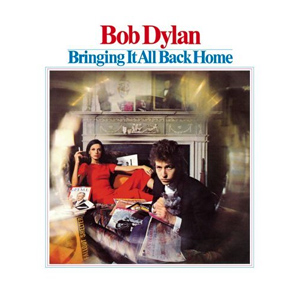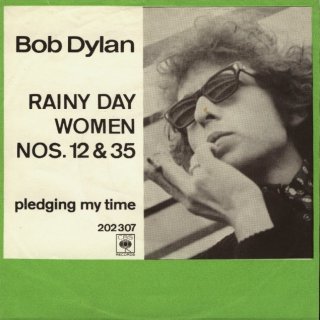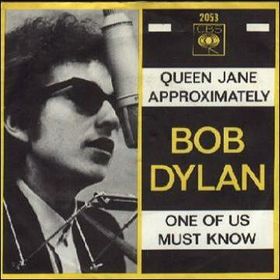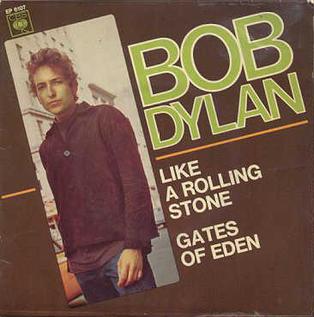Related Research Articles

Blonde on Blonde is the seventh studio album by American singer-songwriter Bob Dylan, released as a double album on June 20, 1966, by Columbia Records. Recording sessions began in New York in October 1965 with numerous backing musicians, including members of Dylan's live backing band, the Hawks. Though sessions continued until January 1966, they yielded only one track that made it onto the final album—"One of Us Must Know ". At producer Bob Johnston's suggestion, Dylan, keyboardist Al Kooper, and guitarist Robbie Robertson moved to the CBS studios in Nashville, Tennessee. These sessions, augmented by some of Nashville's top session musicians, were more fruitful, and in February and March all the remaining songs for the album were recorded.

Bringing It All Back Home is the fifth studio album by American singer-songwriter Bob Dylan. It was released in April 1965, by Columbia Records.
"Mr. Tambourine Man" is a song written by Bob Dylan, released as the first track of the acoustic side of his March 1965 album Bringing It All Back Home. The song's popularity led to Dylan recording it live many times, and it has been included in multiple compilation albums. It has been translated into other languages and has been used or referenced in television shows, films, and books.

Al Kooper is a retired American songwriter, record producer and musician, known for organizing Blood, Sweat & Tears, although he did not stay with the group long enough to share its popularity. Throughout much of the 1960s and 1970s he was a prolific studio musician, playing organ on the Bob Dylan song "Like a Rolling Stone", French horn and piano on the Rolling Stones song "You Can't Always Get What You Want", and lead guitar on Rita Coolidge's "The Lady's Not for Sale", among many other appearances. Kooper also produced a number of one-off collaboration albums, such as the Super Session album that saw him work separately with guitarists Mike Bloomfield and Stephen Stills. In the 1970s Kooper was a successful manager and producer, recording Lynyrd Skynyrd's first three albums. He has also had a successful solo career, writing music for film soundtracks, and has lectured in musical composition.
"Chimes of Freedom" is a song written and performed by Bob Dylan and featured on his Tom Wilson produced 1964 album Another Side of Bob Dylan. The song depicts the thoughts and feelings of the singer and his companion as they shelter from a lightning storm under a doorway after sunset. The singer expresses his solidarity with the downtrodden and oppressed, believing that the thunder is tolling in sympathy for them.
"4th Time Around" is a song by American singer-songwriter Bob Dylan, which was released as the 12th track on his seventh studio album Blonde on Blonde on June 20, 1966. The song was written by Dylan and produced by Bob Johnston. Commentators often interpret it as a parody of the Beatles' 1965 song "Norwegian Wood ". John Lennon composed "Norwegian Wood" after being influenced by the introspective lyrics of Dylan. Lennon later reflected on his feelings of paranoia when Dylan first played him "4th Time Around".
"Visions of Johanna" is a song written and performed by Bob Dylan on his 1966 album Blonde on Blonde. Several critics have acclaimed "Visions of Johanna" as one of Dylan's highest achievements in writing, praising the allusiveness and subtlety of the language. Rolling Stone included "Visions of Johanna" on their list of the 500 Greatest Songs of All Time. In 1999, Sir Andrew Motion, Poet Laureate of the United Kingdom, listed it as the greatest song lyric ever written.
"Sad Eyed Lady of the Lowlands" is a song by American singer-singwriter Bob Dylan. First released as the final track on Dylan's 1966 album Blonde on Blonde, the song lasts 11 minutes and 23 seconds, and occupies the entire fourth side of the double album. The song was written by Dylan and produced by Bob Johnston. Dylan has revealed that the song was written about his wife, Sara Lownds.

Live at The Gaslight 1962 is a live album including ten songs from early Bob Dylan performances recorded in October 1962 at The Gaslight Cafe in New York City's Greenwich Village. Released in 2005 by Columbia Records, it was originally distributed through an exclusive 18-month deal with Starbucks, after which it was released to the general retail market. The album release coincided with the release of the documentary No Direction Home: Bob Dylan.

Bob Dylan is an American singer-songwriter. Often regarded as one of the greatest songwriters of all time, Dylan has been a major figure in popular culture during a career spanning more than 60 years. Much of his most celebrated work dates from the 1960s, when songs such as "Blowin' in the Wind" (1963) and "The Times They Are a-Changin'" (1964) became anthems for the civil rights and antiwar movements. His lyrics during this period incorporated a range of political, social, philosophical, and literary influences, defying pop music conventions and appealing to the burgeoning counterculture.

Robert Sean Wilentz is the George Henry Davis 1886 Professor of American History at Princeton University, where he has taught since 1979. His primary research interests include U.S. social and political history in the nineteenth and twentieth centuries. He has written numerous award-winning books and articles including, most notably, The Rise of American Democracy: Jefferson to Lincoln, which was awarded the Bancroft Prize and was a finalist for the Pulitzer Prize.

"Just Like a Woman" is a song by American singer-songwriter Bob Dylan from his seventh studio album, Blonde on Blonde (1966). The song was written by Dylan and produced by Bob Johnston. Dylan allegedly wrote it on Thanksgiving Day in 1965, though some biographers doubt this, concluding that he most likely improvised the lyrics in the studio. Dylan recorded the song at Columbia Studio A in Nashville, Tennessee in March 1966. The song has been criticized for supposed sexism or misogyny in its lyrics, and has received a mixed critical reaction. Some critics have suggested that the song was inspired by Edie Sedgwick, while other consider that it refers to Dylan's relationship with fellow folk singer Joan Baez. Retrospectively, the song has received renewed praise, and in 2011, Rolling Stone magazine ranked Dylan's version at number 232 in their list of the 500 Greatest Songs of All Time. A shorter edit was released as a single in the United States during August 1966 and peaked at number 33 on the Billboard Hot 100. The single also reached 8th place in the Australian charts, 12th place on the Belgium Ultratop Wallonia listing, 30th in the Dutch Top 40, and 38th on the RPM listing in Canada.

"Rainy Day Women #12 & 35" is a song written and recorded by American singer-songwriter Bob Dylan. Columbia Records first released an edited version as a single in March 1966, which reached numbers two and seven in the US and UK charts respectively. A longer version appears as the opening track of Dylan's seventh studio album, Blonde on Blonde (1966), and has been included on several compilation albums.
"Motorpsycho Nitemare", also known as "Motorpsycho Nightmare", is a song written by American singer-songwriter Bob Dylan that was released in 1964 on his fourth studio album Another Side of Bob Dylan.
"It's Alright, Ma " is a song written and performed by Bob Dylan and first released on his 1965 album Bringing It All Back Home. It was written in the summer of 1964, first performed live on October 10, 1964, and recorded on January 15, 1965. It is described by Dylan biographer Howard Sounes as a "grim masterpiece".

"Pledging My Time" is a blues song by American singer-songwriter Bob Dylan from his seventh studio album, Blonde on Blonde (1966). The song, written by Dylan and produced by Bob Johnston, was recorded on March 8, 1966 in Nashville, Tennessee. Dylan is featured on lead vocals, harmonica, and guitar, backed by guitarist Robbie Robertson and an ensemble of veteran Nashville session men.

"One of Us Must Know (Sooner or Later)" is a song by American singer-songwriter Bob Dylan, which was released as a single on February 14, 1966, and as the fourth track on his seventh studio album Blonde on Blonde in June of that year. The song was written by Dylan and produced by Bob Johnston. It is the narrator's account of a burned-out relationship. It was recorded at Columbia studio A in New York on January 25, 1966, with Dylan and other musicians developing the song through over twenty takes during the session.

"Gates of Eden" is a song by Bob Dylan that appears on his fifth studio album Bringing It All Back Home, released on March 22, 1965 by Columbia Records. It was also released as a single as the B-side of "Like a Rolling Stone". Dylan plays the song solo, accompanying himself on acoustic guitar and harmonica. It is considered one of Dylan's most surreal songs. In a 2005 Mojo magazine poll of its writers and various well-known musicians, "Gates of Eden" was ranked 76th among Dylan's 100 greatest songs.
"I Dreamed I Saw St. Augustine" is a song by Bob Dylan that was originally released on his 1967 album John Wesley Harding. It was recorded at the first John Wesley Harding session on October 17, 1967. It has been covered by many artists, including Joan Baez on her all-Dylan album Any Day Now, as well as by Vic Chesnutt, Eric Clapton, John Doe, Thea Gilmore, Adam Selzer and Dirty Projectors. In addition, Jimi Hendrix at one point intended to cover this song, but felt it was too personal to Dylan and instead covered a different song from the album, "All Along the Watchtower".

"Obviously 5 Believers" is a song by American singer-songwriter Bob Dylan, which was released as the last track of side three of his double album Blonde on Blonde (1966), and was the B-side to the single release of "Just Like a Woman" for releases in America and some other countries. The song was written by Dylan and produced by Bob Johnston. It was recorded at Columbia Music Row Studios, in the early morning hours of a March 9–10, 1966 session. Four takes were recorded, although the first two were incomplete. It has been interpreted as a blues song about loneliness, with critics noting similarities in melody and structure to Memphis Minnie's "Chauffeur Blues". Dylan's vocals and the musicianship of the band on the track have both received critical acclaim, although the track has been regarded as insubstantial by some commentators.
References
- ↑ "The 100 Greatest Bob Dylan Songs". Mojo Magazine. September 2005. Retrieved May 27, 2009.
- ↑ Cotkin, George (2012). Dive Deeper: Journeys with Moby-Dick. Oxford University Press. pp. 254–255. ISBN 978-0-19-998672-9.
- ↑ Wilentz, Sean (June 19, 2021). "Bob Dylan, Historian". The New York Review of Books. Retrieved July 5, 2021.
- ↑ McNally, Dennis (2014). On Highway 61: Music, Race, and the Evolution of Cultural Freedom. Counterpoint. p. 408. ISBN 978-1-61902-449-6.
- ↑ Williams, Paul (2009). Bob Dylan: Performance Artist 1986-1990 And Beyond (Mind Out Of Time): The Life and Music of Bob Dylan. Omnibus Press. ISBN 978-0-85712-118-9.
- ↑ Browne, David (November 4, 2015). "Remembering Bob Dylan's Pioneering Producer Tom Wilson". Rolling Stone . Retrieved August 1, 2020.
- ↑ Marcus, Greil (2006). Like a Rolling Stone: Bob Dylan at the Crossroads. PublicAffairs. ISBN 978-0-7867-3658-4.
- ↑ Dickerson, John (February 7, 2012). "A Weird and Wooly New Mix of Bob Dylan Imitations and Tributes". Slate . Retrieved August 1, 2020.